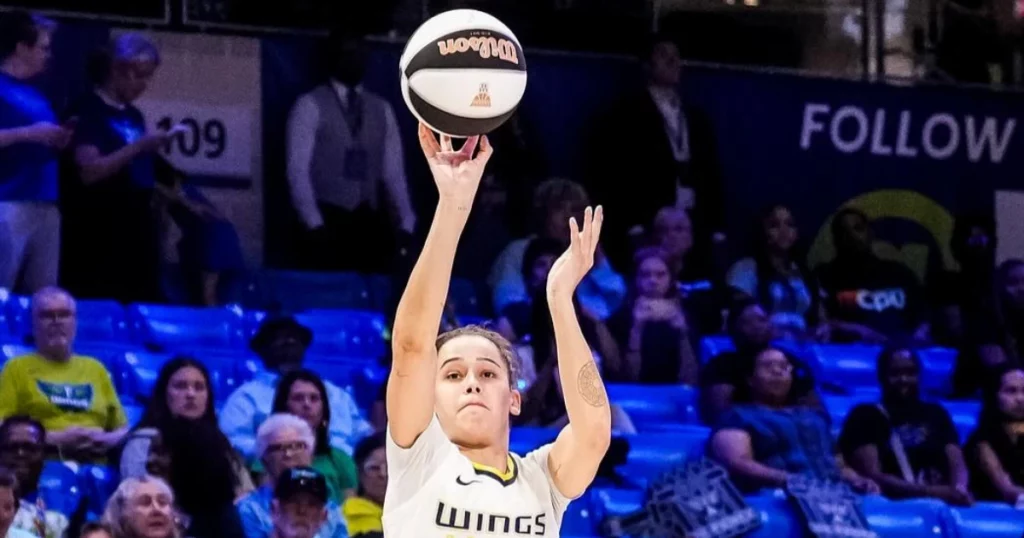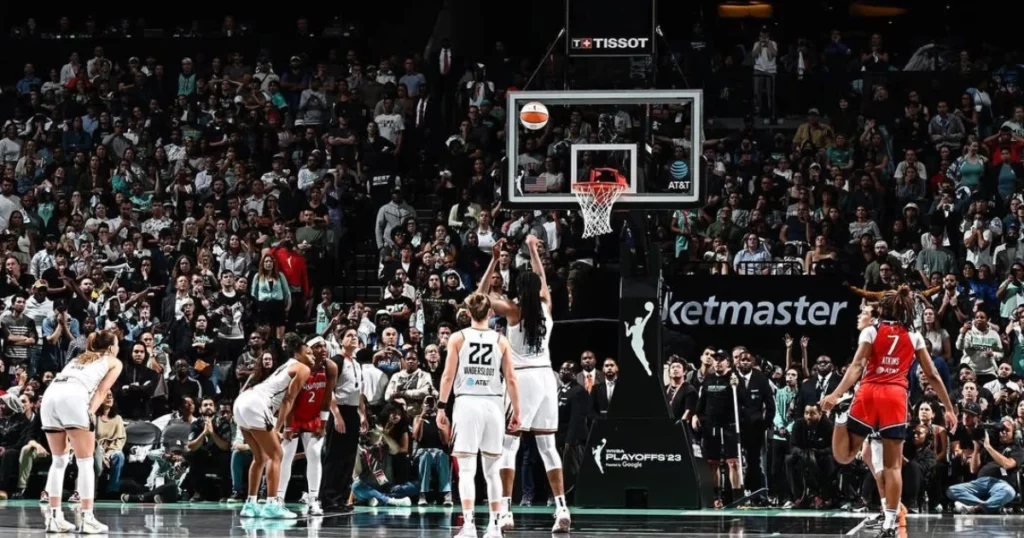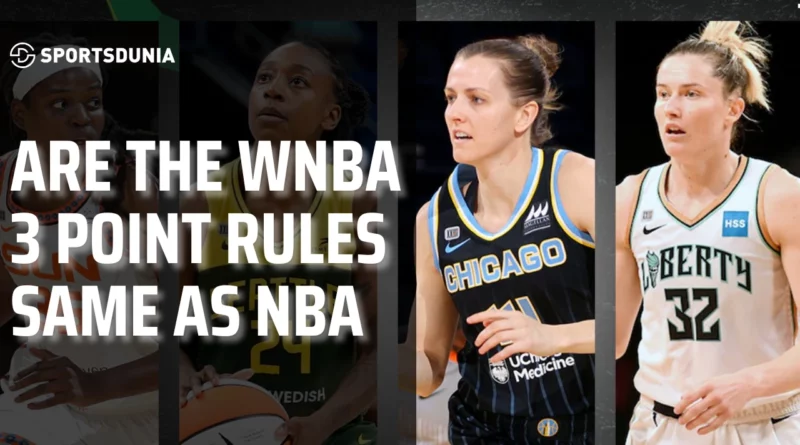Know All About WNBA 3 Point Line: Impact, Rules, and More
A curved boundary marks the three-point line of a basketball court, which grants a three-point value for a basket instead of two points. The NBA uses 23 feet 9 inches for the top scoring zone, while all corners measure 22 feet. Implementing this line delivers strategic gameplay depth to the game by promoting defensive space and improved long-distance shooting with higher-scoring opportunities.
Teams that shoot successfully from the three-point area create defensive stretching while opening driving opportunities for their team and attaining scoring superiority. Through its gradual evolution, the modified free throw distance has reshaped basketball. The perimeter shooting became a fundamental element of contemporary matches.
How Far Is the WNBA 3 Point Line Distance?

There are 22 feet 1.75 inches (6.75 meters) from the basket to the WNBA three-point line except in the corners where it is slightly shorter and measures 21 feet 8 inches (6.6 meters). Before the 2013 season, the WNBA officially implemented FIBA three-point line distances. These correspond to this measurement.
When the WNBA adopted the FIBA three-point distance for its rules during the 2013 season, it selected 20 feet 6.25 inches (6.25 meters) as the standard. However, they decided to lengthen the line because they wanted to improve court spacing and boost outdoor shooting attacks along with greater international compatibility. Strategies and gameplay in the WNBA evolved after adopting the extended three-point line because strong distant shooters gained significant advantages over the years.
The Evolution of the WNBA 3 Point Line
The WNBA implemented the three-point rule when it began its first season in 1997 after the NBA had already adopted this feature. The WNBA 3 point distance of 20 feet 6.25 inches (6.25 meters) from the NCAA women’s standard stimulated outside shooting without disrupting the play balance in the paint and beyond.
Three-point shooting surged in status during the WNBA league so its management team adjusted the distance from the rim to 22 feet 1.75 inches (6.75 meters) around the baseline and 21 feet 8 inches (6.6 meters) in the corners starting in 2013 to match the FIBA format. The alignment with international basketball standards through this court space improvement and extended perimeter shooting distance benefited WNBA matches by maximizing court efficiency.
The WNBA three-point line implementation along with its ongoing modifications has revolutionized tactics during basketball matches. Offensive play requires effective spacing due to teams selecting shooters with strong outside abilities. Expert guards and versatile forwards have emerged thanks to the deep three-point shot since it became a fundamental component of modern WNBA basketball. The greatest three-point shooters in WNBA history are Diana Taurasi for her clutch, Sue Bird for consistency, and Kelsey Plum for her accuracy from outside the arc. These individuals have broken records and redefined perimeter shooting in the league.
Also Read: WNBA Playoff Format: Championships, Qualification Rules, and More
WNBA 3 Point Line Vs NBA 3 Point Line

The three-point lines between the WNBA and the NBA have distinct waiting distances together with varying degrees of game effect. The WNBA’s three-point line is established at 22 feet 1.75 inches (6.75 meters) around the arc in addition to 21 feet 8 inches (6.6 meters) in the corners whereas the NBA takes 23 feet 9 inches (7.24 meters) around the arc together with 22 feet (6.7 meters) in the corners. Triple-pointers in the NBA are harder to make because the line extends farther past the WNBA standards, which adhere to international FIBA norms. The WNBA has shorter cornering three-pointers versus the NBA, but the NBA distance remains marginally greater.
The NBA implemented its three-point line in 1979 yet the WNBA started using it right away in 1997 before expanding the distance to FIBA lengths in 2013. The longer NBA distance benefits players whose distance shots extend further while WNBA players benefit from both perimeter and inside offensive approaches because of their shorter distance. The three-point shot remains essential in both professional basketball leagues, although they continue to differentiate the exact distance permitted.
Impact of the 3 Point Line on the Game
Basketball scoring underwent a significant transformation after adding the three-point line because teams obtained more points and began adapting their offensive approaches. Teams obtained points mainly through mid-range jump shots and inside scoring until the three-pointer brought additional efficiency to outside shots from beyond the arc. Because of perimeter shooting domination, teams rapidly reduced deficits which resulted in more comeback opportunities. As time passed, teams started to view the three-pointer as their key offensive weapon because they built specific plays to deliver open long-distance shots that escalated game scores.
Teams have invented innovative skills that improve their performance when taking three-pointers. Shooting precision and reaching maximum distances now represent essential abilities because most players actively learn to shoot three-pointers as their basic dexterity. Athletes now position themselves strategically to obtain open options for three-pointers because their off-ball movement has improved. When combined with fast-release techniques and improved footwork, athletes become more capable of taking risky field goals.
Basketball players defend the open spaces by closing on shooters swiftly while learning enhanced techniques to protect the three-point area aggressively. The introduction of three-point shooting has revolutionized basketball into a more thrilling sport through better dynamic interactions that depend on skill while requiring deep strategic thinking.
Also Read: Top 10 WNBA players entering 2025 Season: Stats, Net Worth and Records
What is the WNBA 3-point line distance?
The WNBA three-point line is 22 feet 1.75 inches (6.75 meters) from the basket around most of the arc and 21 feet 8 inches (6.6 meters) in the corners.
How many meters is the 3-point line?
The WNBA three-point line is 6.75 meters from the basket around most of the arc and 6.6 meters in the corners.
Are the NBA and WNBA 3-point lines the same?
No, the NBA and WNBA three-point lines are not the same. The WNBA three-point line is 22 feet 1.75 inches (6.75 meters) around the arc and 21 feet 8 inches (6.6 meters) in the corners, while the NBA three-point line is 23 feet 9 inches (7.24 meters) around the arc and 22 feet (6.7 meters) in the corners.
When was the WNBA 3-point line last changed?
The WNBA three-point line was last changed in 2013 when it was extended to 22 feet 1.75 inches (6.75 meters) around the arc and 21 feet 8 inches (6.6 meters) in the corners to match the FIBA international standard. Before this change, the WNBA used the NCAA women’s distance of 20 feet 6.25 inches (6.25 meters).
Why is the WNBA 3-point line shorter than the NBA’s?
The WNBA three-point line is shorter than the NBA’s primarily because it follows FIBA (international) standards, which are designed for a more balanced style of play. The shorter distance allows for greater offensive versatility, making long-range shooting accessible to more players while maintaining competitive gameplay.
Which WNBA player has made the most 3-pointers in history?
Diana Taurasi of the Phoenix Mercury holds the WNBA record for the most career three-pointers made, with 1,447 successful shots from beyond the arc.
Is the WNBA 3-point line closer?
Yes, the WNBA three-point line is closer than the NBA’s. In the WNBA, the three-point line is 22 feet 1.75 inches (6.75 meters) around the arc and 21 feet 8 inches (6.6 meters) in the corners, while in the NBA, it is 23 feet 9 inches (7.24 meters) around the arc and 22 feet (6.7 meters) in the corners. Top 10 WNBA players entering 2025 Season: Stats, Net Worth and Records
